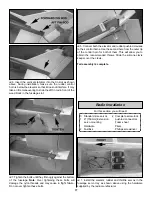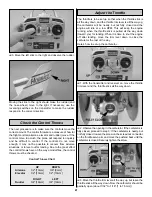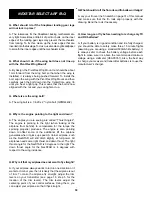
Flight preparation is to be done at the flying field.
Be certain your flight instructor performs these following
checks with you.
1. Get the frequency clip from the frequency control board
at your flying site.
2. Connect the aileron extension and mount the wing to the
fuselage with the nylon wing bolt supplied with this kit.
3. Turn on the transmitter and receiver. One at a time, operate
each control on the airplane using the sticks on the transmitter.
Make certain each control is responding correctly. This must be
done before every flight.There are several types of malfunctions
that can be discovered by performing this elementary task, thus
saving your model!
A range check must be performed before the first flight of a
new model. It is not necessary to do a range check before
every flight (but it is a good idea to perform a range check
before the first flight of each day). A range check is the final
opportunity to reveal any radio malfunctions, and to be
certain the system has adequate operational range.
1. Turn on the transmitter and receiver. Leave the transmitter
antenna all the way down. Walk away from the model while
simultaneously operating the controls. Have an assistant stand
by the model and tell you what the controls are doing to confirm
that they operate correctly. You should be able to walk
approximately 100 feet from the model and still have control
without any “glitching“ or inadvertent servo operation.
2. If everything operates correctly, return to the model and
start the engine. Perform the range check with your
assistant holding the plane with the engine running at
various speeds. If the servos chatter or move inadvertently,
there may be a problem. Do not fly the plane! With the
assistance of your instructor, look for loose servo
connections or binding pushrods. Also be certain you are
the only one on your frequency, and that the battery has
been fully charged.
The NexSTAR ARF comes with a three-line fuel line system. To
fuel the airplane, remove the fuel line plug from the filling line
(green) and connect the fuel pump to it. Disconnect the pink line
from the exhaust. Fill the tank until fuel comes out the pink line.
Re-connect the pink line to the exhaust nipple. Replace the plug
to the fill line. The airplane is now fueled. It is not required but
it is highly recommended that the fuel tank be filled all the
way up before each flight. A full fuel tank will give you 12 to
15 minutes of flight time.
To remove fuel from the fuel tank, remove the fuel line plug
from the filling line (green) and connect the pump to it.
Pump out any fuel that may be in the fuel tank. Replace the
fuel line plug to the green line. NOTE: You may have to lower
the nose of the airplane to completely de-fuel the tank.
Fueling the NexSTAR ARF
Range Check the Radio
Check the Controls
IMPORTANT: Your radio control system transmits a
signal on a certain frequency. Be certain you know what
the frequency is. This is expressed as a two-digit number
(42, 56, etc.), and can be found on the container the
transmitter came in and is also located on the transmitter.
There are several different frequencies, but there is still a
chance that someone else at the flying field may be on
the same frequency as you. If you turn on your
transmitter while that person is flying, a crash will result.
NEVER turn on your transmitter until you have
permission from your instructor, and until you have
possession of the frequency clip used for frequency
control at the flying site.
Check the Frequency
FLIGHT PREPARATION
25
Summary of Contents for NexStar ARF
Page 31: ...31 Correct Angle Rods Fin...
Page 32: ...32...






















